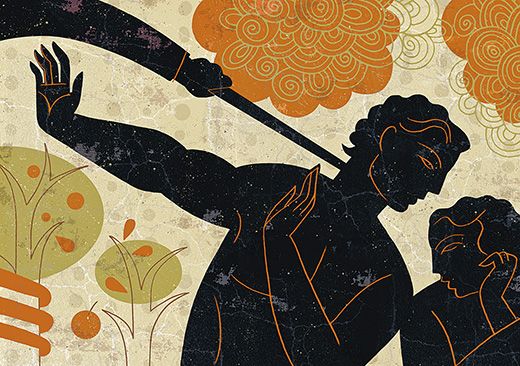How Does the Brain Process Art?
New imaging techniques are mapping the locations of our aesthetic response
/https://tf-cmsv2-smithsonianmag-media.s3.amazonaws.com/filer/Beauty-Hard-Wired-for-Art-631.jpg)
In Michelangelo’s Expulsion from Paradise, a fresco panel on the ceiling of the Sistine Chapel, the fallen-from-grace Adam wards off a sword-wielding angel, his eyes averted from the blade and his wrist bent back defensively. It is a gesture both wretched and beautiful. But what is it that triggers the viewer’s aesthetic response—the sense that we’re right there with him, fending off blows?
Recently, neuroscientists and an art historian asked ten subjects to examine the wrist detail from the painting, and—using a technique called transcranial magnetic stimulation (TMS)—monitored what happened in their brains. The researchers found that the image excited areas in the primary motor cortex that controlled the observers’ own wrists.
“Just the sight of the raised wrist causes an activation of the muscle,” reports David Freedberg, the Columbia University art history professor involved in the study. This connection explains why, for instance, viewers of Degas’ ballerinas sometimes report that they experience the sensation of dancing—the brain mirrors actions depicted on the canvas.
Freedberg’s study is part of the new but growing field of neuroaesthetics, which explores how the brain processes a work of art. The discipline emerged 12 years ago with publication of British neuroscientist Semir Zeki’s book, Inner Vision: An Exploration of Art and the Brain. Today, related studies depend on increasingly sophisticated brain-imaging techniques, including TMS and functional magnetic resonance imaging (fMRI), which maps blood flow and oxygenation in the brain. Scientists might monitor an observer’s reaction to a classical sculpture, then warp the sculpture’s body proportions and observe how the viewer’s response changes. Or they might probe what occurs when the brain contemplates a Chinese landscape painting versus an image of a simple, repetitive task.
Ulrich Kirk, a neuroscientist at the Virginia Tech Carilion Research Institute, is also interested in artworks’ contexts. Would a viewer respond the same way to a masterpiece enshrined in the Louvre if he beheld the same work displayed in a less exalted setting, such as a garage sale? In one experiment, Kirk showed subjects a series ofimages—some, he explained, were fine artwork; others were created by Photoshop. In reality, none were Photoshop-generated; Kirk found that different areas of viewers’ brains fired up when he declared an image to be “art.”
Kirk also hopes one day to plumb the brains of artists themselves. “You might be able to image creativity as it happens, by putting known artists in the fMRI,” he says.
Others, neuroscientists included, worry that neuroscience offers a reductionist perspective. Vilayanur Ramachandran, a neuroscientist at the University of California at San Diego, says that neuroaesthetics undoubtedly “enriches our understanding of human aesthetic experience.” However, he adds, “We have barely scratched the surface...the quintessence of art, and of genius, still eludes us—and may elude us forever.”
